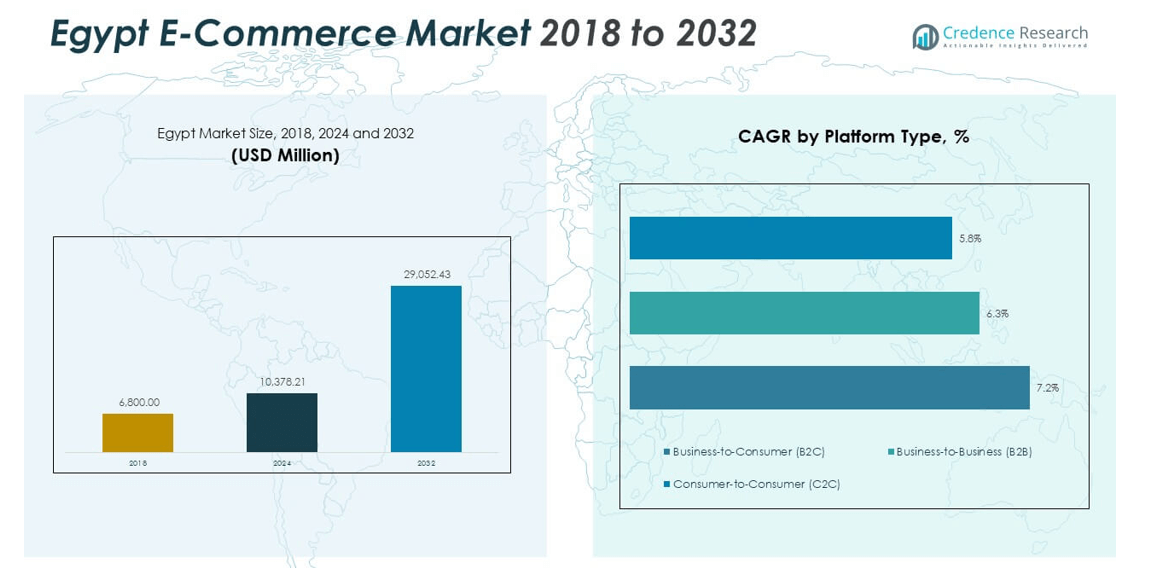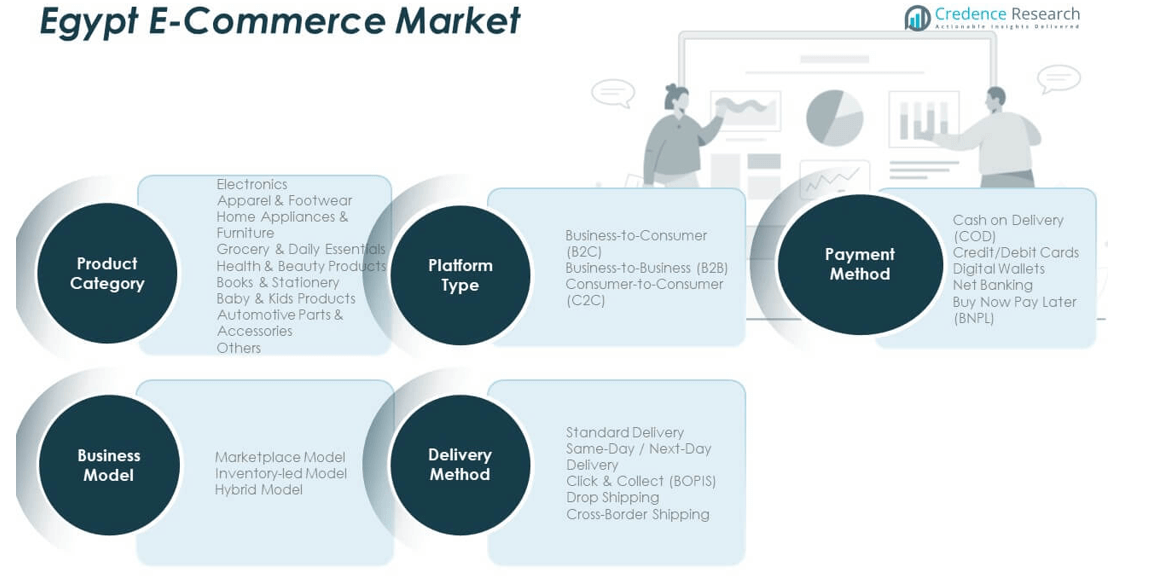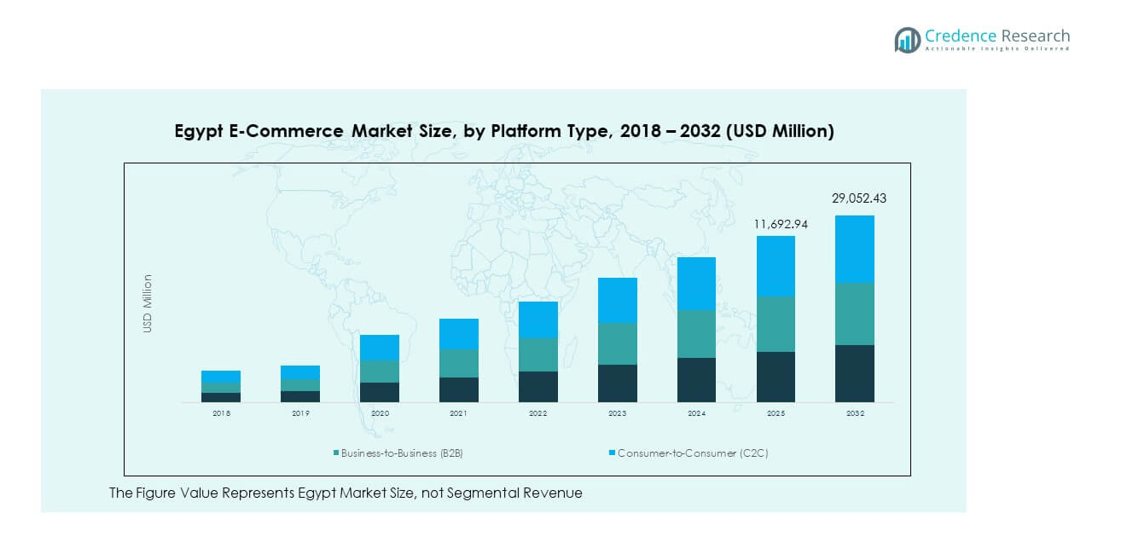CHAPTER NO. 1 : INTRODUCTION 19
1.1.1. Report Description 19
Purpose of the Report 19
USP & Key Offerings 19
1.1.2. Key Benefits for Stakeholders 19
1.1.3. Target Audience 20
1.1.4. Report Scope 20
CHAPTER NO. 2 : EXECUTIVE SUMMARY 21
2.1. Egypt E-Commerce Market Snapshot 21
2.1.1. Egypt E-Commerce Market, 2018 – 2032 (USD Million) 23
CHAPTER NO. 3 : EGYPT E-COMMERCE MARKET – INDUSTRY ANALYSIS 24
3.1. Introduction 24
3.2. Market Drivers 25
3.2.1. Growing Internet & Smartphone Penetration 25
3.2.2. Rising Digital Payments Adoption 26
3.3. Market Restraints 27
3.3.1. Low Trust in Online Transactions 27
3.4. Market Opportunities 28
3.4.1. Market Opportunity Analysis 28
3.5. Porter’s Five Forces Analysis 29
CHAPTER NO. 4 : ANALYSIS COMPETITIVE LANDSCAPE 30
4.1. Company Market Share Analysis – 2024 30
4.1.1. Egypt E-Commerce Market: Company Market Share, by Volume, 2024 30
4.1.2. Egypt E-Commerce Market: Company Market Share, by Revenue, 2024 31
4.1.3. Egypt E-Commerce Market: Top 6 Company Market Share, by Revenue, 2024 31
4.1.4. Egypt E-Commerce Market: Top 3 Company Market Share, by Revenue, 2024 32
4.2. Egypt E-Commerce Market Company Revenue Market Share, 2024 33
4.3. Company Assessment Metrics, 2024 34
4.3.1. Stars 34
4.3.2. Emerging Leaders 34
4.3.3. Pervasive Players 34
4.3.4. Participants 34
4.4. Start-ups /SMEs Assessment Metrics, 2024 34
4.4.1. Progressive Companies 34
4.4.2. Responsive Companies 34
4.4.3. Dynamic Companies 34
4.4.4. Starting Blocks 34
4.5. Strategic Developments 35
4.5.1. Acquisitions & Mergers 35
New Product Launch 35
Egypt Expansion 35
4.6. Key Players Product Matrix 36
CHAPTER NO. 5 : PESTEL & ADJACENT MARKET ANALYSIS 37
5.1. PESTEL 37
5.1.1. Political Factors 37
5.1.2. Economic Factors 37
5.1.3. Social Factors 37
5.1.4. Technological Factors 37
5.1.5. Environmental Factors 37
5.1.6. Legal Factors 37
5.2. Adjacent Market Analysis 37
CHAPTER NO. 6 : EGYPT E-COMMERCE MARKET – BY PRODUCT CATEGORY SEGMENT ANALYSIS 38
6.1. Egypt E-Commerce Market Overview, by Product Category Segment 38
6.1.1. Egypt E-Commerce Market Revenue Share, By Product Category, 2023 & 2032 39
6.1.2. Egypt E-Commerce Market Attractiveness Analysis, By Product Category 40
6.1.3. Incremental Revenue Growth Opportunity, by Product Category, 2024 – 2032 40
6.1.4. Egypt E-Commerce Market Revenue, By Product Category, 2018, 2023, 2027 & 2032 41
6.2. Electronics 42
6.3. Apparel & Footwear 43
6.4. Home Appliances & Furniture 44
6.5. Grocery & Daily Essentials 45
6.6. Health & Beauty Products 46
CHAPTER NO. 7 : EGYPT E-COMMERCE MARKET – BY PLATFORM TYPE SEGMENT ANALYSIS 47
7.1. Egypt E-Commerce Market Overview, by Platform Type Segment 47
7.1.1. Egypt E-Commerce Market Revenue Share, By Platform Type, 2023 & 2032 48
7.1.2. Egypt E-Commerce Market Attractiveness Analysis, By Platform Type 49
7.1.3. Incremental Revenue Growth Opportunity, by Platform Type, 2024 – 2032 49
7.1.4. Egypt E-Commerce Market Revenue, By Platform Type, 2018, 2023, 2027 & 2032 50
7.2. Business-to-Consumer (B2C) 51
7.3. Business-to-Business (B2B) 52
7.4. Consumer-to-Consumer (C2C) 53
CHAPTER NO. 8 : EGYPT E-COMMERCE MARKET – BY PAYMENT METHOD SEGMENT ANALYSIS 54
8.1. Egypt E-Commerce Market Overview, by Payment Method Segment 54
8.1.1. Egypt E-Commerce Market Revenue Share, By Payment Method, 2023 & 2032 55
8.1.2. Egypt E-Commerce Market Attractiveness Analysis, By Payment Method 56
8.1.3. Incremental Revenue Growth Opportunity, by Payment Method, 2024 – 2032 56
8.1.4. Egypt E-Commerce Market Revenue, By Payment Method, 2018, 2023, 2027 & 2032 57
8.2. Cash on Delivery (COD) 58
8.3. Credit/Debit Cards 59
8.4. Digital Wallets 60
8.5. Net Banking 61
8.6. Buy Now Pay Later (BNPL) 62
CHAPTER NO. 9 : EGYPT E-COMMERCE MARKET – BY BUSINESS MODEL SEGMENT ANALYSIS 63
9.1. Egypt E-Commerce Market Overview, by Business Model Segment 63
9.1.1. Egypt E-Commerce Market Revenue Share, By Business Model, 2023 & 2032 64
9.1.2. Egypt E-Commerce Market Attractiveness Analysis, By Business Model 65
9.1.3. Incremental Revenue Growth Opportunity, by Business Model, 2024 – 2032 65
9.1.4. Egypt E-Commerce Market Revenue, By Business Model, 2018, 2023, 2027 & 2032 66
9.2. Marketplace Model 67
9.3. Inventory-led Model 68
9.4. Hybrid Model 69
CHAPTER NO. 10 : EGYPT E-COMMERCE MARKET – BY DELIVERY METHOD SEGMENT ANALYSIS 70
10.1. Egypt E-Commerce Market Overview, by Delivery Method Segment 70
10.1.1. Egypt E-Commerce Market Revenue Share, By Distribution Channel, 2023 & 2032 71
10.1.2. Egypt E-Commerce Market Attractiveness Analysis, By Distribution Channel 72
10.1.3. Incremental Revenue Growth Opportunity, by Distribution Channel, 2024 – 2032 72
10.1.4. Egypt E-Commerce Market Revenue, By Distribution Channel, 2018, 2023, 2027 & 2032 73
10.2. Standard Delivery 74
10.3. Same-Day / Next-Day Delivery 75
10.4. Click & Collect (BOPIS) 76
10.5. Drop Shipping 77
10.6. Cross-Border Shipping 78
CHAPTER NO. 11 : EGYPT E-COMMERCE MARKET – EGYPT ANALYSIS 79
11.1. Product Category 79
11.1.1. Egypt E-Commerce Market Revenue, By Product Category, 2018 – 2023 (USD Million) 79
11.1.2. Egypt E-Commerce Market Revenue, By Product Category, 2024 – 2032 (USD Million) 79
11.2. Platform Type 80
11.2.1. Egypt E-Commerce Market Revenue, By Platform Type, 2018 – 2023 (USD Million) 80
11.2.2. Egypt E-Commerce Market Revenue, By Platform Type, 2024 – 2032 (USD Million) 80
11.3. Payment Method 81
11.3.1. Egypt E-Commerce Market Revenue, By Payment Method, 2018 – 2023 (USD Million) 81
11.3.2. Egypt E-Commerce Market Revenue, By Payment Method, 2024 – 2032 (USD Million) 81
11.4. Business Model 82
11.4.1. Egypt E-Commerce Market Revenue, By Business Model, 2018 – 2023 (USD Million) 82
11.4.2. Egypt E-Commerce Market Revenue, By Business Model, 2024 – 2032 (USD Million) 82
11.5. Distribution Channel 83
11.5.1. Egypt E-Commerce Market Revenue, By Distribution Channel, 2018 – 2023 (USD Million) 83
11.5.2. Egypt E-Commerce Market Revenue, By Distribution Channel, 2024 – 2032 (USD Million) 83
CHAPTER NO. 12 : COMPANY PROFILES 84
12.1. Amazon Egypt 84
12.1.1. Company Overview 84
12.1.2. Product Portfolio 84
12.1.3. Swot Analysis 84
12.1.4. Business Strategy 85
12.1.5. Financial Overview 85
12.2. Jumia 86
12.3. Elaraby Group 86
12.4. Carrefour 86
12.5. Hanimex 86
12.6. Fawry 86
12.7. Breadfast 86
12.8. Chefaa 86
12.9. elmenus 86
12.10. Taager 86
12.11. MaxAB 86
12.12. Okhtein 86
12.13. Yodawy 86
12.14. Manzzeli 86
12.15. Homzmart 86
List of Figures
FIG NO. 1. Egypt E-Commerce Market Revenue, 2018 – 2032 (USD Million) 23
FIG NO. 2. Porter’s Five Forces Analysis for Egypt E-Commerce Market 29
FIG NO. 3. Company Share Analysis, 2024 30
FIG NO. 4. Company Share Analysis, 2024 31
FIG NO. 5. Company Share Analysis, 2024 31
FIG NO. 6. Company Share Analysis, 2024 32
FIG NO. 7. Egypt E-Commerce Market – Company Revenue Market Share, 2024 33
FIG NO. 8. Egypt E-Commerce Market Revenue Share, By Product Category, 2023 & 2032 39
FIG NO. 9. Market Attractiveness Analysis, By Product Category 40
FIG NO. 10. Incremental Revenue Growth Opportunity by Product Category, 2024 – 2032 40
FIG NO. 11. Egypt E-Commerce Market Revenue, By Product Category, 2018, 2023, 2027 & 2032 41
FIG NO. 12. Egypt E-Commerce Market for Electronics, Revenue (USD Million) 2018 – 2032 42
FIG NO. 13. Egypt E-Commerce Market for Apparel & Footwear, Revenue (USD Million) 2018 – 2032 43
FIG NO. 14. Egypt E-Commerce Market for Home Appliances & Furniture, Revenue (USD Million) 2018 – 2032 44
FIG NO. 15. Egypt E-Commerce Market for Grocery & Daily Essentials, Revenue (USD Million) 2018 – 2032 45
FIG NO. 16. Egypt E-Commerce Market for Health & Beauty Products, Revenue (USD Million) 2018 – 2032 46
FIG NO. 17. Egypt E-Commerce Market Revenue Share, By Platform Type, 2023 & 2032 48
FIG NO. 18. Market Attractiveness Analysis, By Platform Type 49
FIG NO. 19. Incremental Revenue Growth Opportunity by Platform Type, 2024 – 2032 49
FIG NO. 20. Egypt E-Commerce Market Revenue, By Platform Type, 2018, 2023, 2027 & 2032 50
FIG NO. 21. Egypt E-Commerce Market for Business-to-Consumer (B2C), Revenue (USD Million) 2018 – 2032 51
FIG NO. 22. Egypt E-Commerce Market for Business-to-Business (B2B), Revenue (USD Million) 2018 – 2032 52
FIG NO. 23. Egypt E-Commerce Market for Consumer-to-Consumer (C2C), Revenue (USD Million) 2018 – 2032 53
FIG NO. 24. Egypt E-Commerce Market Revenue Share, By Payment Method, 2023 & 2032 55
FIG NO. 25. Market Attractiveness Analysis, By Payment Method 56
FIG NO. 26. Incremental Revenue Growth Opportunity by Payment Method, 2024 – 2032 56
FIG NO. 27. Egypt E-Commerce Market Revenue, By Payment Method, 2018, 2023, 2027 & 2032 57
FIG NO. 28. Egypt E-Commerce Market for Cash on Delivery (COD), Revenue (USD Million) 2018 – 2032 58
FIG NO. 29. Egypt E-Commerce Market for Credit/Debit Cards, Revenue (USD Million) 2018 – 2032 59
FIG NO. 30. Egypt E-Commerce Market for Digital Wallets, Revenue (USD Million) 2018 – 2032 60
FIG NO. 31. Egypt E-Commerce Market for Net Banking, Revenue (USD Million) 2018 – 2032 61
FIG NO. 32. Egypt E-Commerce Market for Buy Now Pay Later (BNPL), Revenue (USD Million) 2018 – 2032 62
FIG NO. 33. Egypt E-Commerce Market Revenue Share, By Business Model, 2023 & 2032 64
FIG NO. 34. Market Attractiveness Analysis, By Business Model 65
FIG NO. 35. Incremental Revenue Growth Opportunity by Business Model, 2024 – 2032 65
FIG NO. 36. Egypt E-Commerce Market Revenue, By Business Model, 2018, 2023, 2027 & 2032 66
FIG NO. 37. Egypt E-Commerce Market for Marketplace Model, Revenue (USD Million) 2018 – 2032 67
FIG NO. 38. Egypt E-Commerce Market for Inventory-led Model, Revenue (USD Million) 2018 – 2032 68
FIG NO. 39. Egypt E-Commerce Market for Hybrid Model, Revenue (USD Million) 2018 – 2032 69
FIG NO. 40. Egypt E-Commerce Market Revenue Share, By Distribution Channel, 2023 & 2032 71
FIG NO. 41. Market Attractiveness Analysis, By Distribution Channel 72
FIG NO. 42. Incremental Revenue Growth Opportunity by Distribution Channel, 2024 – 2032 72
FIG NO. 43. Egypt E-Commerce Market Revenue, By Distribution Channel, 2018, 2023, 2027 & 2032 73
FIG NO. 44. Egypt E-Commerce Market for Standard Delivery, Revenue (USD Million) 2018 – 2032 74
FIG NO. 45. Egypt E-Commerce Market for Same-Day / Next-Day Delivery, Revenue (USD Million) 2018 – 2032 75
FIG NO. 46. Egypt E-Commerce Market for Click & Collect (BOPIS), Revenue (USD Million) 2018 – 2032 76
FIG NO. 47. Egypt E-Commerce Market for Drop Shipping, Revenue (USD Million) 2018 – 2032 77
FIG NO. 48. Egypt E-Commerce Market for Cross-Border Shipping, Revenue (USD Million) 2018 – 2032 78
List of Tables
TABLE NO. 1. : Egypt E-Commerce Market: Snapshot 21
TABLE NO. 2. : Drivers for the Egypt E-Commerce Market: Impact Analysis 25
TABLE NO. 3. : Restraints for the Egypt E-Commerce Market: Impact Analysis 27
TABLE NO. 4. : Egypt E-Commerce Market Revenue, By Product Category, 2018 – 2023 (USD Million) 79
TABLE NO. 5. : Egypt E-Commerce Market Revenue, By Product Category, 2024 – 2032 (USD Million) 79
TABLE NO. 6. : Egypt E-Commerce Market Revenue, By Platform Type, 2018 – 2023 (USD Million) 80
TABLE NO. 7. : Egypt E-Commerce Market Revenue, By Platform Type, 2024 – 2032 (USD Million) 80
TABLE NO. 8. : Egypt E-Commerce Market Revenue, By Payment Method, 2018 – 2023 (USD Million) 81
TABLE NO. 9. : Egypt E-Commerce Market Revenue, By Payment Method, 2024 – 2032 (USD Million) 81
TABLE NO. 10. : Egypt E-Commerce Market Revenue, By Business Model, 2018 – 2023 (USD Million) 82
TABLE NO. 11. : Egypt E-Commerce Market Revenue, By Business Model, 2024 – 2032 (USD Million) 82
TABLE NO. 12. : Egypt E-Commerce Market Revenue, By Distribution Channel, 2018 – 2023 (USD Million) 83
TABLE NO. 13. : Egypt E-Commerce Market Revenue, By Distribution Channel, 2024 – 2032 (USD Million) 83






